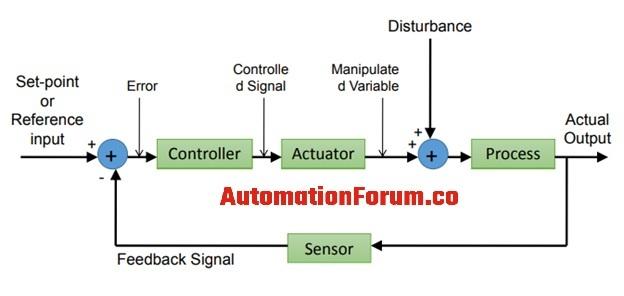Systemcomposition
Theautomaticcontrolsystemiscomposedofthecontrollerandthecontrolledobject.However,toachievecomplexcontroltasks,atypicalautomaticcontrolsystemshouldusuallyalsoinclude:fixed-valuecomponents,actuators,measurementandtransmissioncomponents,andcomparisoncomponents.
Historicaldevelopment
Aftermorethan20yearsofdevelopment,China'sindustrialautomaticcontrolsystemdevicemanufacturingindustryhasmadeconsiderabledevelopment,especiallysincethe1990s,China'sindustrialautomaticcontrolsystemdeviceTheoutputofthemanufacturingindustryhasbeenmaintainedatanannualgrowthrateofmorethan20%.In2011,China'sindustrialautomaticcontrolsystemdevicemanufacturingindustryachievedremarkableresults.Thetotalindustrialoutputvalueoftheyearwas205.604billionyuan;theproductsalesincomewas19,673billionyuan,ayear-on-yearincreaseof24.66%;thetotalprofitrealizedwas20.284billionyuan,ayear-on-yearincreaseof28.74%.Domestically-madeautomaticcontrolsystemshavesuccessivelymadebreakthroughsinthefieldsofthermalpower,fertilizerandoilrefining.
ThemainbodyofChina'sindustrialautomationmarketismainlycomposedofsoftwareandhardwaremanufacturers,systemintegrators,andproductdistributors.Inthefieldofsoftwareandhardwareproducts,themid-to-high-endmarketisalmostentirelymonopolizedbywell-knownforeignbrandproducts,andthissituationwillcontinuetobemaintained;inthefieldofsystemintegration,multinationalcompaniesoccupythehigh-endofthemanufacturingindustry,andcompanieswithdeepindustrybackgroundsareintegratingsystemsinrelatedindustries.Systemintegrationcompaniesthattaketheinitiativeintheirbusinessandhaveextensiveapplicationexperiencearefullofcompetitiveness.
Intheindustrialautomationmarket,thereisamisalignmentbetweensupplyanddemand.Whatcustomersneedisacompleteelectricalcontrolsystemthatcanmeettheirownmanufacturingprocesses,whilesuppliersprovideavarietyofstandardizeddeviceproducts.Differentindustrieshaveverybigdifferencesinelectricalcontrol,andevencustomersinthesameindustryhaveverydifferentrequirementsduetotheirdifferentprocesses.Thiscontradictionbetweensupplyanddemandcreatesdevelopmentspacefortheindustrialautomationindustry.
Chinahastheworld'slargestindustrialautomationcontrolsystemequipmentmarket.Traditionalindustrialtechnologytransformation,factoryautomation,andenterpriseinformationizationrequirealargenumberofindustrialautomationsystems,andthemarketprospectsarebroad.Industrialcontrolautomationtechnologyisdevelopingtowardsintelligence,networkingandintegration.Basedonthegooddevelopmentprospectsofindustrialautomationcontrol,itisestimatedthatthemarketsizeoftheindustrialautomaticcontrolsystemdevicemanufacturingindustrywillexceed350billionyuanin2015.
Ascompetitionintheindustrialautomaticcontrolsystemequipmentmanufacturingindustrycontinuestointensify,mergersandacquisitionsandcapitaloperationsamonglarge-scaleindustrialautomaticcontrolsystemequipmentmanufacturersarebecomingmorefrequent,anddomesticoutstandingindustrialautomaticcontrolsystemequipmentmanufacturersareincreasing.Paymoreattentiontotheresearchontheindustrymarket,especiallythein-depthresearchontheindustrydevelopmentenvironmentandproductbuyers.
Systemclassification
Accordingtodifferentcontrolprinciples,automaticcontrolsystemsaredividedintoopen-loopcontrolsystemsandClosedloopcontrolsystem.
Open-loopcontrolsystem
Intheopen-loopcontrolsystem,theoutputofthesystemisonlycontrolledbytheinput,andthecontrolaccuracyandinterferencesuppressioncharacteristicsarerelativelypoor.Intheopen-loopcontrolsystem,thelogiccontrolbasedonthesequenceiscalledthesequentialcontrolsystem;itiscomposedofsequentialcontroldevices,detectionelements,actuatorsandcontrolledindustrialobjects.Mainlyusedintheprocesscontrolofmachinery,chemicalindustry,materialhandlingandtransportation,aswellasmanipulatorsandautomaticproductionlines.
Closed-loopcontrolsystem
Theclosed-loopcontrolsystemisbasedontheprincipleoffeedback.Thedeviationbetweentheoutputandtheexpectedvalueisusedtocontrolthesystem,andbettercontrolperformancecanbeobtained.Closedloopcontrolsystemisalsocalledfeedbackcontrolsystem.
Accordingtothegivensignalclassification,theautomaticcontrolsystemcanbedividedintoconstantvaluecontrolsystem、Follow-upcontrolsystemandProgramcontrolsystem.
Constantvaluecontrolsystem
Asysteminwhichthegivenvalueremainsunchanged,andthesystemoutputisrequiredtobeclosetothegivendesiredvaluewithacertainaccuracy.Forexample,theautomaticcontrolsystemoftemperature,pressure,flow,liquidlevel,motorspeedintheproductionprocessisaconstantvaluesystem.
Follow-upcontrolsystem
Thesetvaluechangesaccordingtoanunknowntimefunction,andtheoutputisrequiredtofollowthechangeofthesetvalue.Suchastheradarantennasystemthatfollowsthesatellite.
Programcontrolsystem
Thegivenvaluechangesaccordingtoacertaintimefunction.Suchasprogram-controlledmachinetools.
Applicationfields
Automaticcontrolsystemshavebeenwidelyusedinvariousfieldsofhumansociety.
Inindustry,forvariousphysicalquantitiesencounteredintheproductionprocessofmetallurgy,chemicalindustry,machinerymanufacturing,etc.,includingtemperature,flow,pressure,thickness,tension,speed,position,frequency,phase,etc.Thereisacorrespondingcontrolsystem.Onthisbasis,throughtheuseofdigitalcomputers,adigitalcontrolsystemwithbettercontrolperformanceandahigherdegreeofautomation,andaprocesscontrolsystemwithdualfunctionsofcontrolandmanagementhavebeenestablished.Applicationsinagricultureincludeautomaticwaterlevelcontrolsystems,automaticoperatingsystemsforagriculturalmachinery,andsoon.
Intermsofmilitarytechnology,applicationexamplesofautomaticcontrolincludevarioustypesofservosystems,firecontrolsystems,guidanceandcontrolsystems,etc.Inaerospace,aviationandnavigation,inadditiontovariousformsofcontrolsystems,applicationareasalsoincludenavigationsystems,remotecontrolsystemsandvarioussimulators.
Inaddition,automaticcontroltechnologyalsohaspracticalapplicationsinofficeautomation,librarymanagement,trafficmanagementandevendailyhousework.Withthedevelopmentofcontroltheoryandcontroltechnology,theapplicationfieldsofautomaticcontrolsystemsarestillexpanding,involvingalmostallfieldssuchasbiology,medicine,ecology,economy,andsociety.
Otherrelated
Relatedtextbooks
Booktitle:Automaticcontrolsystem/Generalhighereducation15nationalplanningtextbook
ISBN:704012559
Author:LiXianyun
Publisher:HigherEducationPress
Pricing:23.3
Pages:285
Publicationdate:2003-7-1
Edition:1
Format:16K
Packaging:Paperback
Introduction:Thisbookisthe"TenthFive-YearPlan"nationalplanningtextbookforgeneralhighereducation(highervocationalandtechnicaleducation).Thisbookisaimedatthecharacteristicsofhighervocationalandtechnicaleducation.Thetheoreticalknowledgeisexplainedtotheextentthatitmustbesufficient,andtheapplicationabilityisemphasized.Thetrainingoftheself-controlprinciple,whichismoredifficulttounderstand,willbeintroducedintotheexplanationoftheautomaticcontrolsystem.Thebookintroducestheclosed-loopcontrolsystemofDCspeedcontrol,reversibleDCspeedcontrolsystem,DCpulsewidthspeedcontrolsystem,digitalDCspeedcontrolsystem,asynchronousmotorvariableslipspeedcontrolsystem,asynchronousmotorvariablefrequencyspeedcontrolsystem,etc.
TableofContents
ChapterOne
IntroductiontoPrinciplesofAutomaticControl
1.1Overview
1.1.1Introduction
1.1.2Structureofcontrolsystem
1.1.3Classificationofcontrolsystem
1.1.4Basicrequirementsofcontrolsystem
1.1.5AnalysisandDesignofControlSystem
1.2SystemMathematicalModelandTransferFunction
1.2.1MethodofEstablishingMathematicalModel
1.2.2ControlSystemDifferentialequation
1.2.3Transferfunctionofcontrolsystem
1.2.4Dynamicstructurediagramofcontrolsystem
1.3Typicallinksandfeedbackcontrol
1.3.1TypicalLinks
1.3.2FeedbackControl
QuestionsandExercises
ChapterTwoAnalysisandCalibrationofAutomaticControlSystem
p>2.1Systemtimedomainanalysis
2.1.1Basicconcepts
2.1.2First-ordersystemstepresponseanalysis
2.1.3TwoAnalysisofStepResponseofStepSystem
2.2StabilityAnalysisofAutomaticControlSystem
2.2.1BasicConceptsofSystemStability
2.2.2SystemStabilityConditions
2.2.3Systemsteady-stateperformanceanalysis
2.3Systemfrequencydomainanalysis
2.3.1Basicconcepts
2.3.2Bodediagramofautomaticcontrolsystem
2.3.3Basicconceptofsystemfrequencydomainstability
2.4Frequencydomaincorrectionofautomaticcontrolsystem
2.4.1BasicConcept
2.4.2Calibrationmethodofautomaticcontrolsystem
2.5IntroductiontoMATLABandSIMULINKapplication
2.5.1IntroductiontoMATLABapplication
2.5.2IntroductiontoSIMULINKApplication
QuestionsandExercises
ChapterThreeClosed-loopDCSpeedControlSystem
3.1IntroductiontoDCSpeedControlSystem
3.1.1SpeedcontrolindexandbasicmethodofDCspeedcontrol
3.1.2StructureofDCspeedcontrolsystem
3.1.3DetectionmethodofDCspeedcontrolsystem
3.1.4Analysisofopenloopcharacteristicsofthyristor-motorsystem
3.2TransferfunctionoftypicallinksinDCspeedcontrolsystem
3.2.1Thyristortriggerrectifierdevice
p>3.2.2DCmotor
3.2.3Proportional,integralandproportional-integralregulator
3.2.4Tachogenerator
3.3Analysisofsingleclosedloopspeedcontrolsystem
3.3.1YesStaticdifferentialspeednegativefeedbackDCspeedcontrolsystem
3.3.2NostaticdifferentialspeednegativefeedbackDCspeedcontrolsystem
3.3.3Otherfeedbackinthesingleclosed-loopDCspeedcontrolsystemApplication
3.4Analysisofspeedandcurrentdoubleclosedloopspeedcontrolsystem
3.4.1Compositionandworkingprincipleofdoubleclosedloopspeedcontrolsystem
3.4.2DoubleclosedloopSteadystateanalysisofspeedcontrolsystem
3.4.3Dynamicanalysisofdoubleclosedloopspeedcontrolsystem
3.5Engineeringdesignofspeedandcurrentdoubleclosedloopsystemregulator
3.5.1Introductiontotheengineeringdesignmethodoftheregulator
3.5.2Therelationshipbetweenthetypicalsystemanditsparametersandperformanceindicators
3.5.3Thechoiceoftheregulator
3.5.4Approximatetreatmentofthetransferfunctionofthecontrolobject
3.5.5UsingMATLABtoassistinthedesignofcurrentandspeeddoubleclosed-loopsystemregulators
3.6Introductiontoothermulti-loopspeedcontrolsystems
p>3.6.1Theroleoftheinnerloopofthemulti-loopcontrolsystem
3.6.2Introductiontothemulti-loopspeedcontrolsystem
Thinkingquestionsandexercises
Chapter4ReversibleDCSpeedControlSystem
4.1ImplementationmethodofreversibleDCspeedcontrolsystem
4.1.1Reversiblearmaturereverseconnectioncircuit
4.1.2Excitationreverseconnectionreversiblecircuit
4.1.3Comparisonofarmaturereverseconnectionreversiblecircuitandexcitationreverseconnectionreversiblecircuit
4.2CirculatingcurrentanalysisofreversibleDCspeedcontrolsystem
4.2.1Typesofcirculation
4.2.2Analysisofstaticcirculation
4.3ReversibleDCspeedcontrolsystemwithcirculation
4.3.1α=βworkReversibleDCspeedcontrolsystemwithcirculatingcurrent
4.3.2ReversibleDCspeedcontrolsystemwithcontrollablecirculatingcurrent
4.4ReversibleDCspeedcontrolsystemwithoutcirculatingcurrent
4.4.1Logicalnon-circulatingcurrentreversibleDCspeedcontrolsystem
4.4.2Dislocationnon-circulatingcurrentreversibleDCspeedcontrolsystem
Thinkingquestionsandexercises
Chapter5DCPulsewidthspeedregulationsystem
5.1Pulsewidthmodulationconverter
5.1.1IrreversiblePWMconverter
5.1.2ReversiblePWMconverter
5.2Open-loopmechanicalcharacteristicsofpulsewidthspeedregulationsystem
5.3Controlcircuitofpulsewidthspeedregulationsystem
5.3.1Pulsewidthmodulator

5.3.2Logicdelaylink
5.3.3Basedriver
5.4SpecialproblemsofDCpulsewidthspeedregulationsystem
5.4.1Currentpulsation
5.4.2Rotationalspeedpulsation
5.4.3SwitchinglossandoptimalswitchingofpowertransistorFrequency
5.4.4Pumpingvoltagelimitcircuit
Thinkingquestionsandexercises
Chapter6PositionFollowingSystem
6.1PositionControlprinciple
6.1.1Classificationofpositionfollowingsystem
6.1.2Positioncontrolmethod
6.2Detectionelementofpositionfollowingsystem
6.2.1Resolver
6.2.2Grating
6.2.3Inductionsynchronizer
6.3Analysisanddesignofpositionservosystem
6.3.1Staticerroranalysisofpositionservosystem
6.3.2Dynamiccorrectiondesignofpositionservosystem
Thinkingquestionsandexercises
SeventhChapterACVoltageRegulationSystemandCascadeSpeedRegulation
7.1BasicPrinciplesofACSpeedRegulation
7.1.1CharacteristicsofACSpeedRegulationSystem
7.1.2ClassificationofACspeedcontrolsystem
7.2ACvoltageandspeedcontrolsystem
7.2.1Principleandcircuitofvoltageandspeedcontrolsystem
7.2.2MechanicalcharacteristicsanalysisofACvoltageandspeedcontrolsystem
7.3Cascadespeedcontrolsystem
7.3.1Basicprincipleofcascadespeedcontrolsystem
7.3.2Mechanicalcharacteristicsofcascadespeedcontrolsystem
7.3.3Analysisofdoubleclosed-loopcascadespeedcontrolsystem
Thinkingquestionsandexercises
Chapter8AsynchronousMotorVariableVoltagefrequencyconversionspeedregulationsystem
8.1Basiccontrolmethodoffrequencyconversionspeedregulation
8.1.1Speedregulationbelowthebasefrequency
8.1.2Speedregulationabovethebasefrequency
8.2Mechanicalcharacteristicsofasynchronousmotorvariablefrequencyspeedregulation
8.2.1Mechanicalcharacteristicsofconstantvoltageandconstantfrequencycontrolasynchronousmotor
8.2.2ConstantvoltageandconstantfrequencyPerformanceanalysisofvariablefrequencyspeedregulationforcontrollingasynchronousmotors
8.3SpeedOpenLoopVariableFrequencySpeedRegulationSystem
8.3.1AC-DC-ACVoltageTypeInverterSpeedOpen-loopVariableFrequencyRegulationSpeedsystem
8.3.2Open-loopvariablefrequencyspeedregulationsystemofcurrent-typeinverter
8.4Speedclosed-loopspeedregulationsystemcontrolledbyslipfrequency
8.4.1Thebasicconceptofslipfrequencycontrol
8.4.2Thelawofslipfrequencycontrol
8.4.3Thefrequencyconversionspeedcontrolsystemofslipfrequencycontrol
8.5Asynchronousmotorvectorconversioncontrolsystem
8.5.1Basicprincipleofasynchronousmotorvectorconversioncontrol
8.5.2Vectorconversionoperationlawandrealization
8.5.3MathematicalModelofAsynchronousMotorinVectorConversionControl
8.5.4BasicEquationofVectorConversionControlofAsynchronousMotor
8.5.5AsynchronousMotorVectorConversionControlSystem
8.6DirectTorqueControlofAsynchronousMotor
8.6.1FeaturesofDirectTorqueControl
8.6.2DirectTorqueControlBasicprinciples
8.6.3Thebasiccontrolschemeofasynchronousmotortorquecontrol
Thinkingquestionsandexercises
Chapter9Inverterapplicationtechnology
9.1Classificationandmainfunctionsofinverterdevices
9.1.1Classificationofinverterdevices
9.1.2Mainfunctionsofgeneralinverter
9.2Selectionoftheinverter
9.2.1Selectionofthetypeofinverter
9.2.2Selectionofcontrolmode
9.2.3Controlsystem
9.2.4Invertercapacityselection
9.2.5Inverterperipheralequipmentselection
9.3Motorcapacityselection
9.4Cableselection
9.5TheconnectionbetweentheinverterandthePLCandthehostcomputer
9.5.1Theinputandoutputcircuitoftheinverter
9.5.2Problemsthatshouldbepaidattentiontowhenusing
p>9.5.3Controlthroughdatatransmission
9.5.4Groundingandpowersupplysystem
9.6Installation,debugginganduseofinverter
9.6.1Installationofgeneralinverter
9.6.2Wiringofinverter
9.6.3Commissioningofgeneralinverter
9.6.4GeneralinverterHowtousethecontroller
Thinkingquestionsandexercises
Chapter10FullydigitalACandDCspeedcontrolsystem
10.1Overview
10.1.1Theoverallstructureofthesystem
10.1.2Thedesignmethodsandstepsofthemotordigitalcontrolsystem
10.1.3Thehardwaresystemdesignmethodsandstepsofthemotordigitalcontrolsystem
10.1.4Determinationoftheoverallschemeofthemotordigitalcontrolsystem
10.1.5Selectionofthemicroprocessorchip
10.1.6Softwareofthecontrolsystem
10.1.7Featuresofdigitalspeedcontrolsystem
10.2FullydigitalDCspeedcontrolsystem
10.2.1OverviewofthedigitaldevelopmentofDCspeedcontrolsystemsathomeandabroad
10.2.2Introductionto32-bitfullydigitalDCtransmission
10.2.3Applicationexamples
10.3Microcomputer-controlledACspeedregulationsystem
10.3.1DivisionoffunctionalmodulesAndmicrocomputersystemstructure
10.3.2Microcomputercontrolofvectorcontrolsystem
10.3.3DesignofmicrocomputerfrequencyconversioncontroldeviceforACmotor
Thinkingquestionsandexercises
attachedListofcommonlyusedsymbols
Machiningtextbook
Title:Automaticcontrolsystem-workingprinciple,performanceanalysisandsystemdebugging
2ndedition1disc
Level:HigherVocationalCollege
Support:ElectronicCourseware
Author:KongFancai
Publisher:MachineryIndustryPress
Publishingtime:2011-01-20
ISBN:9787111115298
Format:16open
Pricing:¥36.0
Introduction
Thecontentofthisbookisdividedinto3parts:Thefirstchaptermainlyfocusesonthephysicalprocess,anddescribesthecommonlyuseddetectioncomponents,Theworkingprincipleofbasiccomponentssuchascommonlyusedmotorsandpowerelectronicpowersupplycircuits(4-30credithours).Thesecondcontentincludessystemmathematicalmodel,MATLABsoftwareanditsapplication,systemperformanceanalysisandsystemcalibration,etc.Thisarticlemainlystartsfromthetransferfunctionandsystemblockdiagram,appliesSimulinksystemsimulationanalysis,mainlyqualitativeanalysis,expoundstheinfluenceofeachlink(andeachparameter)onthesystemperformanceandthewaytoimprovetheperformance(24hours).Thethirdchapterisabouttheworkingprinciple,performanceanalysisandsystemdebuggingofvariouscommontypicalautomaticcontrolsystems(16~48classhours).Frombasicknowledge→automaticcontrolprinciple→automaticcontrolsystem→specificcircuit→systemdebugging→faulttroubleshooting,thisbookprovidesreaderswithacompletecognitiveprocessandapracticalprocessofintegratingtheorywithpractice.Thecontentiscomprehensiveandrich.Thisbookischaracterizedbyitsnewcontent,integratingtheorywithpractice,highlightingtheanalysisofphysicalprocesses,payingattentiontotheelaborationofmethodology,payingattentiontothereviewandapplicationofbasicknowledge,detailedanalysis,andeasy-to-understand.Andaccordingtodifferentprofessionalrequirements,thereare6kindsofprogramstochoosefrom(50to96hours).Eachchapterinthebookhasasummary,thinkingquestionsandexercises,mostofwhicharepracticalproblemsinproduction.Thebookalsoarrangesmorereadingmaterials,casestudiesandpicturereadingexercisestofacilitatetheimprovementofstudents'self-study,analysisandpracticalability.Inaddition,thereisanintroductiontothecontentofpracticalprojectsandcorrespondingpracticaldevicesthatarematchedwiththeteachingmaterials.Inordertofacilitatetheuseofthenewversionoftheteachingmaterials,thisbookalsocomeswithasupportingmultimediaCD(CAICD).ThecontentsoftheCD-ROMinclude[TeachingGuide],[ReferenceElectronicTeachingPlan],[Self-studyTutorial],[DifficultProblemSolving],[CaseAnalysis]and[PracticalEquipmentandExperiments,TrainingGuide],etc.ThisCD-ROMwillbeofgreathelptoteachers'teachingandstudents'learning.Thisbookisavailableforelectricalengineeringmajors,appliedelectronicsmajors,mechanicalmajors,mechatronicsmajors,CNCmachinetoolmaintenancemajors,andcomputerapplicationmajorsinappliedundergraduates,techniciancolleges,technicalcolleges,highervocationaltechnicalcolleges,andworkers’universities.Professionalselection,itcanalsobeusedasareferenceforengineeringandtechnicalpersonnel,andcanbeusedasatechnicaltrainingmaterialfortechniciansandseniortechnicians.
TableofContents
Foreword
Part1OverviewofAutomaticControlSystemandBasicComponentsofTypicalAutomaticControlSystem
Chapter1OverviewofAutomaticControlSystem
Chapter2CommonlyUsedDetectionComponents
Chapter3WorkingPrincipleofCommonlyUsedMotors
Chapter4PowerElectronicPowerSupplyCircuits
Chapter5Commonlyusedregulatorcircuits
Chapter2PrinciplesofAutomaticControl
Chapter6LaplaceTransformation
Chapter7MathematicalModelofAutomaticControlSystem
Chapter8PerformanceAnalysisofAutomaticControlSystem
Chapter9WaystoImproveAutomaticControlSystemPerformance
Chapter3WorkingPrinciple,PerformanceAnalysisandSystemDebuggingofTypicalAutomaticControlSystem
Chapter10WaterLevelControlSystemandTemperatureControlSystem
Chapter11ThyristorDCSpeedControlSystem
p>
Chapter12BipolarTransistor(BJT)PulseWidthModulation(PWM)ControlledDCSpeedControlSystem
Chapter13InsulatedGateBipolarTransistor(IGBT)SinusoidalPulseWidthModulation(SPWM))ControlledACSpeedControlSystem
Chapter14PositionServoSystem
Chapter15Analysis,DebuggingandTroubleshootingofAutomaticControlSystem
Appendix
ThecontentofBaiduBaikeiseditedbynetizens.Ifyoufindthatthecontentofyourentryisinaccurateorimperfect,pleaseuseyourownwordsArticleeditingservice(freeofcharge)toparticipateintheamendment.Gonow>>
